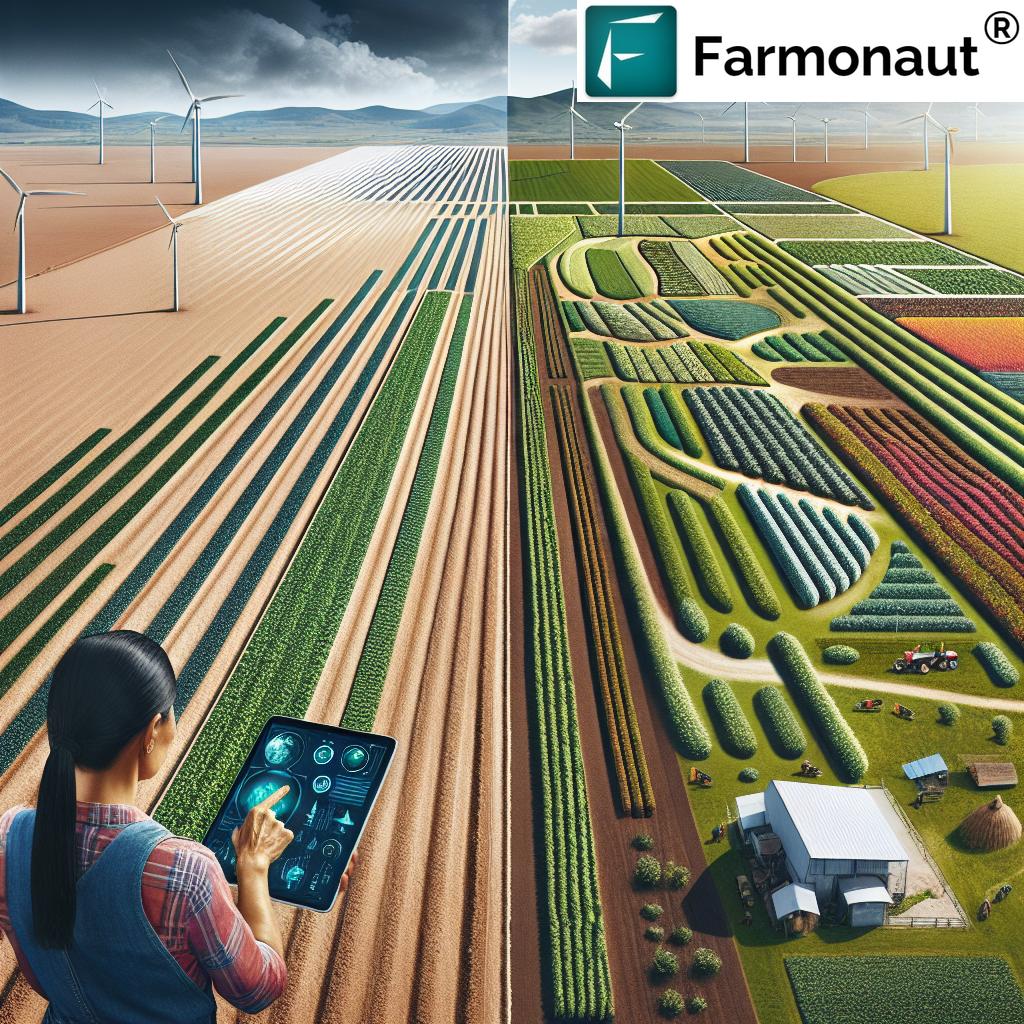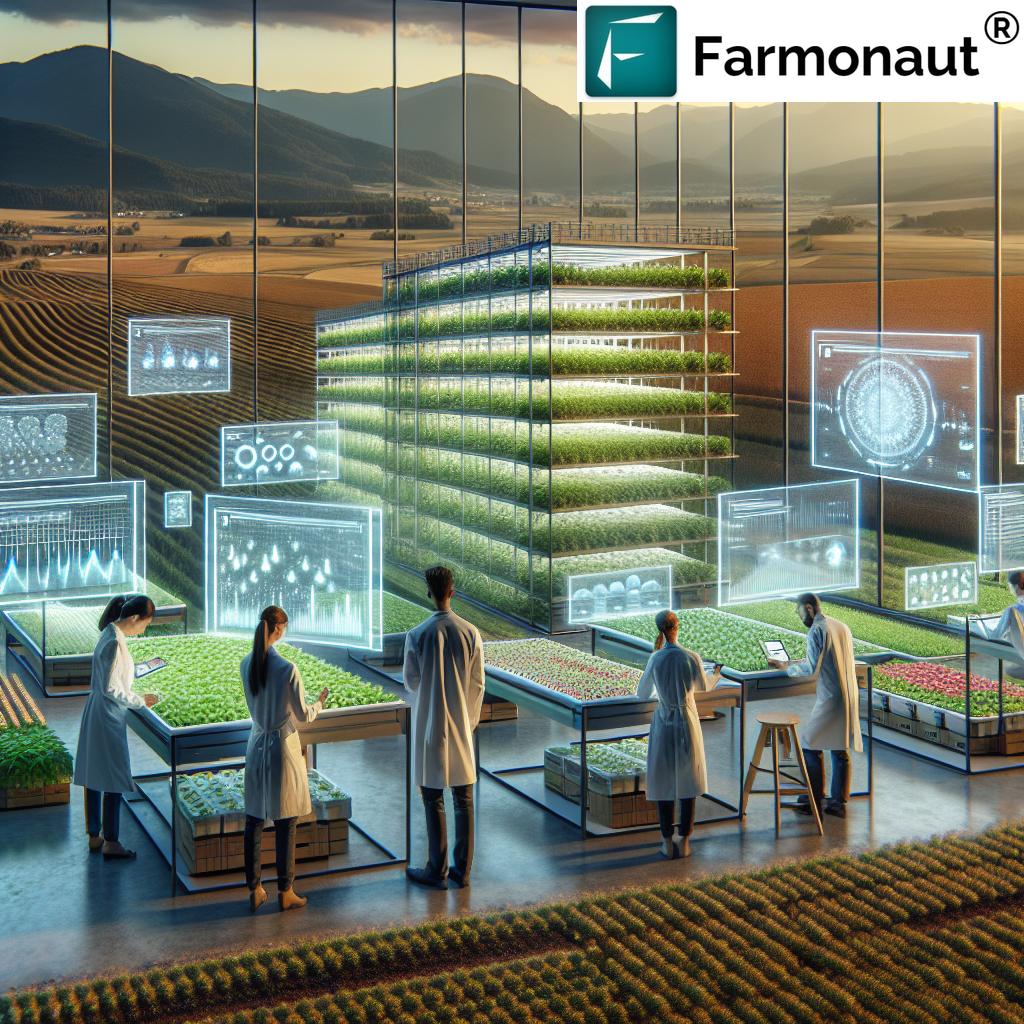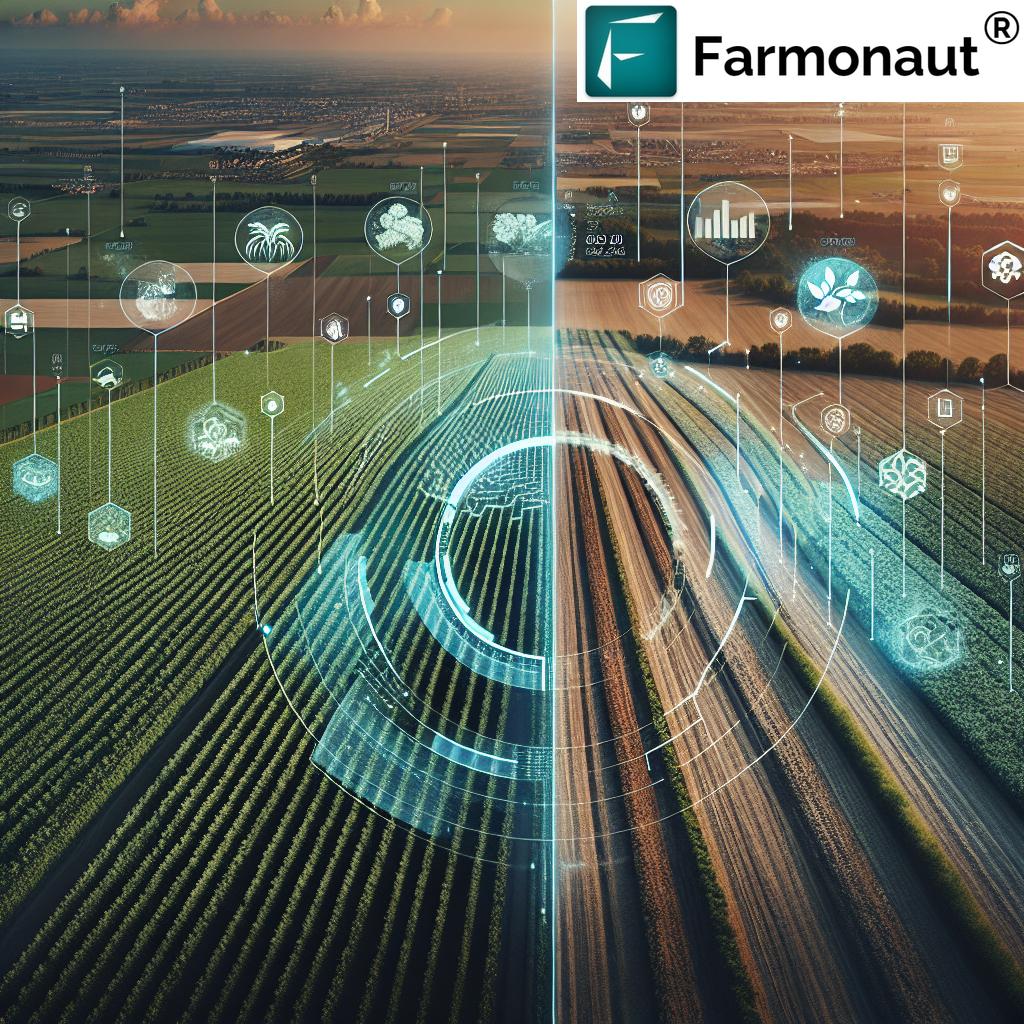Revolutionizing European Agriculture: How Regenerative Practices Are Shaping a Sustainable Future for Polish and Hungarian Farmlands
“Regenerative agriculture practices are being implemented across thousands of hectares in Poland, Hungary, and the UK.”
In the heart of Europe, a quiet revolution is taking place across the fertile lands of Poland, Hungary, and the United Kingdom. As we delve into the world of regenerative agriculture, we uncover a transformative approach that’s not just changing the way we farm, but also how we think about the future of our planet. This sustainable farming movement is reshaping landscapes, revitalizing soils, and redefining the relationship between agriculture and the environment.
At Farmonaut, we’re at the forefront of this agricultural renaissance, providing cutting-edge satellite-based farm management solutions that empower farmers to make data-driven decisions. Our mission aligns perfectly with the goals of regenerative agriculture: to make precision farming accessible and affordable while promoting sustainable practices that benefit both farmers and the planet.

The Rise of Regenerative Agriculture in Europe
Regenerative agriculture is more than just a trend; it’s a necessary evolution in farming practices to address the pressing issues of soil degradation, climate change, and food security. Across Europe, farmers are embracing techniques that go beyond sustainability to actively regenerate and revitalize the land. Let’s explore how this movement is taking root in Poland, Hungary, and the UK, and the impact it’s having on the agricultural landscape.
- Poland: Polish farmers are leading the charge in adopting cover crops and minimal tillage practices across thousands of hectares.
- Hungary: Hungarian agriculture is seeing a surge in crop rotation and organic matter incorporation, improving soil health dramatically.
- United Kingdom: British farmers are focusing on agroforestry and integrating livestock into cropping systems for enhanced biodiversity.
These practices are not just improving soil health; they’re also contributing significantly to carbon sequestration, helping combat climate change while boosting agricultural productivity. As we at Farmonaut witness through our satellite imagery and data analysis, the transformation of these landscapes is truly remarkable.
Key Regenerative Practices Transforming European Farmlands
The success of regenerative agriculture in Europe is built on a foundation of proven practices that work in harmony with nature. Let’s delve into some of the key techniques that are making a significant impact:
- Cover Crops: By planting cover crops during off-seasons, farmers are protecting soil from erosion, enhancing organic matter, and improving soil structure.
- Crop Rotation: Diversifying crop sequences helps break pest cycles, improves nutrient cycling, and increases overall farm resilience.
- Minimal Tillage: Reducing soil disturbance preserves soil structure, retains moisture, and protects beneficial soil organisms.
- Organic Matter Incorporation: Adding compost and crop residues back into the soil boosts its fertility and water-holding capacity.
- Agroforestry: Integrating trees with crops or livestock creates diverse ecosystems that enhance biodiversity and provide multiple income streams.
These practices are not only environmentally beneficial but also economically sound. Farmers implementing these techniques often see reduced input costs, improved crop yields, and greater resistance to extreme weather events.
At Farmonaut, we provide tools that help farmers monitor the impact of these practices in real-time. Our satellite-based crop health monitoring and AI advisory systems offer invaluable insights into vegetation health, soil moisture levels, and overall farm performance. This data-driven approach allows farmers to fine-tune their regenerative practices for optimal results.

The Environmental Impact of Regenerative Agriculture
“Sustainable farming techniques like cover crops and minimal tillage can significantly reduce greenhouse gas emissions in agriculture.”
The environmental benefits of regenerative agriculture are far-reaching and multifaceted. As we analyze the data from our satellite imagery and on-ground sensors, we’re seeing remarkable improvements across various ecological indicators:
- Carbon Sequestration: Regenerative practices are turning farmlands into carbon sinks, actively pulling CO2 from the atmosphere and storing it in the soil.
- Biodiversity Enhancement: Diverse crop rotations and reduced chemical inputs are creating havens for pollinators and beneficial insects.
- Water Quality Improvement: Better soil structure and reduced runoff are leading to cleaner waterways and reduced eutrophication.
- Soil Health Restoration: Increased organic matter and microbial activity are revitalizing once-depleted soils.
- Climate Resilience: Healthier soils with improved water retention capabilities are better equipped to withstand droughts and floods.
These environmental improvements are not just good for the planet; they’re essential for the long-term viability of agriculture itself. By nurturing the ecosystem that supports food production, regenerative agriculture is securing a more sustainable future for generations to come.
Economic Incentives and Support for Farmers
The transition to regenerative agriculture is not just an environmental imperative; it’s also becoming increasingly economically attractive. Across Europe, various initiatives are providing financial incentives and expert support to farmers adopting these sustainable practices:
- Government Subsidies: Many European countries are offering per-hectare payments for implementing specific regenerative practices.
- Carbon Credit Programs: Farmers can now monetize their carbon sequestration efforts through emerging carbon markets.
- Eco-Certification Premiums: Products from regenerative farms often command higher prices in the marketplace.
- Reduced Input Costs: As soil health improves, the need for synthetic fertilizers and pesticides often decreases.
- Yield Stability: Regenerative practices can lead to more consistent yields, even in challenging weather conditions.
At Farmonaut, we’re committed to supporting farmers in this transition. Our platform provides the data and insights needed to optimize regenerative practices, helping farmers maximize both environmental and economic benefits. From our API for developers to our user-friendly mobile apps, we’re making precision agriculture accessible to all.
Measuring and Reporting Environmental Impact
As the saying goes, “You can’t manage what you don’t measure.” This principle is especially true in regenerative agriculture, where tracking progress is crucial for continuous improvement and demonstrating value. Here’s how farmers and researchers are quantifying the impact of regenerative practices:
- Soil Organic Carbon (SOC) Testing: Regular soil tests track changes in carbon content over time.
- Biodiversity Assessments: Surveys of plant and animal species provide insights into ecosystem health.
- Water Quality Monitoring: Testing of nearby water bodies shows the reduction in agricultural runoff.
- Crop Yield Analysis: Comparing yields before and after implementing regenerative practices demonstrates productivity impacts.
- Greenhouse Gas Emissions Calculation: Estimating the carbon footprint of farm operations helps quantify climate impact.
At Farmonaut, we’re proud to offer tools that support these measurement efforts. Our satellite-based monitoring provides valuable data on vegetation health, soil moisture, and land use changes. This information, combined with on-ground measurements, creates a comprehensive picture of the farm’s environmental impact.
The Global Implications of European Regenerative Agriculture
The regenerative agriculture movement in Europe is not happening in isolation. Its success has far-reaching implications for global food systems and climate change mitigation efforts:
- Knowledge Transfer: Lessons learned in European fields are being shared with farmers worldwide.
- Supply Chain Transformation: As more European farms adopt regenerative practices, it’s influencing global agricultural supply chains.
- Climate Action: European regenerative agriculture is contributing significantly to global carbon sequestration efforts.
- Food Security: Improved soil health and resilience are enhancing long-term food production capacity.
- Policy Influence: European successes are informing agricultural policies in other parts of the world.
As a global company, Farmonaut is well-positioned to facilitate this knowledge transfer. Our API developer documentation allows agricultural innovators worldwide to integrate our satellite data into their solutions, spreading the benefits of precision agriculture across borders.
Challenges and Future Directions
While the progress in regenerative agriculture is impressive, it’s not without its challenges. As we look to the future, several key areas require attention:
- Education and Training: Continued efforts are needed to train farmers in regenerative techniques.
- Policy Support: Long-term policy frameworks are crucial for sustaining the transition to regenerative agriculture.
- Technology Integration: Further development of precision agriculture tools will help optimize regenerative practices.
- Market Development: Expanding markets for regenerative products will provide additional incentives for farmers.
- Research and Innovation: Ongoing research is needed to refine practices and adapt to changing climate conditions.
At Farmonaut, we’re committed to addressing these challenges. Our continuous innovation in satellite technology and AI-driven insights aims to make regenerative agriculture more accessible and effective for farmers of all scales.
Comparison of Regenerative Agriculture Practices in European Countries
| Country | Primary Regenerative Practices | Estimated Hectares Under Regenerative Management | Key Crops Benefiting | Estimated Carbon Sequestration (tons CO2e/year) | Observed Soil Health Improvements | Estimated Increase in Crop Yields (%) | Water Quality Impact | Biodiversity Improvement | Government Incentives (€/hectare/year) |
|---|---|---|---|---|---|---|---|---|---|
| Poland | Cover crops, Minimal tillage | 4,600+ | Wheat, Maize, Rapeseed | 23,000 | Significant increase in organic matter | 10-15% | Medium | Medium | 150-200 |
| Hungary | Crop rotation, Organic matter incorporation | 9,100+ | Wheat, Maize, Sunflower | 45,500 | Improved soil structure and water retention | 15-20% | High | High | 180-250 |
| United Kingdom | Agroforestry, Integrated livestock systems | 3,200+ | Wheat, Barley, Oilseed rape | 16,000 | Enhanced soil biodiversity | 8-12% | Medium | High | 200-300 |
Conclusion: A Sustainable Future for European Agriculture
As we’ve explored throughout this article, regenerative agriculture is more than just a set of farming practices; it’s a holistic approach to land management that’s reshaping the future of European agriculture. From the fertile fields of Poland to the diverse landscapes of Hungary and the UK, farmers are proving that it’s possible to produce abundant food while nurturing the environment.
The benefits are clear: healthier soils, increased biodiversity, improved water quality, and significant contributions to climate change mitigation. Moreover, the economic incentives and support systems emerging around regenerative agriculture are making it an increasingly viable option for farmers of all scales.
At Farmonaut, we’re proud to be part of this agricultural revolution. Our satellite-based technologies and AI-driven insights are helping farmers implement and optimize regenerative practices, bridging the gap between traditional farming wisdom and cutting-edge precision agriculture.
As we look to the future, the path forward is clear. Continued investment in research, education, and technology will be crucial to scaling up regenerative agriculture across Europe and beyond. By working together – farmers, researchers, policymakers, and technology providers – we can create a more resilient, productive, and sustainable agricultural system that benefits both people and the planet.
The revolution in European agriculture is well underway. It’s time for all of us to play our part in nurturing this movement, ensuring a bountiful and sustainable future for generations to come.
FAQ Section
- What is regenerative agriculture?
Regenerative agriculture is a holistic land management approach that focuses on improving soil health, enhancing biodiversity, and increasing carbon sequestration. It includes practices like minimal tillage, cover cropping, and crop rotation. - How does regenerative agriculture differ from conventional farming?
Conventional farming often relies on intensive tillage, synthetic inputs, and monocultures. Regenerative agriculture, in contrast, works with natural processes to build soil health, reduce inputs, and create diverse ecosystems. - What are the main benefits of regenerative agriculture?
Key benefits include improved soil health, increased biodiversity, enhanced water retention, reduced erosion, carbon sequestration, and often improved crop yields and farm profitability. - How does regenerative agriculture contribute to fighting climate change?
Regenerative practices help sequester carbon in the soil, reduce greenhouse gas emissions from farming activities, and create more resilient agricultural systems that can better withstand climate extremes. - Are there financial incentives for farmers to adopt regenerative practices?
Yes, many European countries offer subsidies, carbon credit programs, and premium prices for products from regenerative farms. Additionally, these practices often lead to reduced input costs over time. - How can technology like Farmonaut’s help in implementing regenerative agriculture?
Farmonaut’s satellite-based monitoring and AI advisory systems provide real-time data on crop health, soil moisture, and other key metrics. This helps farmers make informed decisions about implementing and optimizing regenerative practices. - What are some challenges in transitioning to regenerative agriculture?
Common challenges include the initial learning curve, potential short-term yield dips, upfront costs for new equipment or practices, and the need for ongoing education and support. - How long does it take to see results from regenerative practices?
While some benefits can be observed within the first year, significant improvements in soil health and ecosystem function often take 3-5 years to fully manifest. - Can regenerative agriculture be practiced on large-scale commercial farms?
Yes, regenerative principles can be adapted to farms of all sizes. Many large-scale operations in Europe are successfully implementing these practices. - How does regenerative agriculture impact food quality?
By improving soil health and reducing synthetic inputs, regenerative agriculture often leads to more nutrient-dense crops and healthier livestock, potentially improving the nutritional quality of food produced.




















